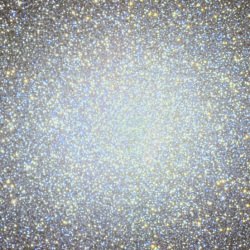
Omega Centauri by Bernd Flach-Wilken and Volker Wendel
For thousands of years, we saw ourselves as the focal point of the Universe and the center of all things. Then, in the early 16th century, Copernicus revealed that this was not the case; humanity’s home was a huge globe spinning once every 24 hours circling the distant Sun on an annual basis. Over the next 400 years, this idea begrudgingly gained acceptance. But it was not until early in the last century, when Harlow Shapley measured the distance to several globular clusters like the one in this picture, that humanity next understood we were located far from the Milky Way’s center, then believed to be the center of the Universe, and therefore even less special in the grand scheme of things.
The Milky Way is surrounded by swarms of similarly aged stars held together by the mutual gravitational attraction of their individual constituents. These clumps of Suns are known as Globular Clusters and our galaxy has about two hundred of them orbiting its massive central region. About nine years after Shapley used globular clusters to determined we were not the center of the Milky Way Universe, Edwin Hubble proved that the Universe is filled with a hundred billion galaxies of which the Milky Way is but one example. His discovery was the latest demotion that mankind has suffered and around many of these distant island universes, swarms of globular clusters have also been observed hovering above their centers. Thus, the dazzling beauty of globular clusters has played a significant role in recent history by helping us understand our true place in the vastness of the Cosmos.
Of all the globular clusters associated with the Milky Way galaxy, none are larger or more luminous than Omega Centauri, located 15,000 light years away toward the constellation of Centaurus. This ball of light is estimated to contain about 10 million stars and is so large that it takes light 150 years to travel from a star on one side to a star on the other. In the local group of galaxies, only one other globular cluster, part of the Andromeda Galaxy, is larger. Under dark skies, Omega Centaurus can be seen with the naked eye as a fuzzy star and it is often mistaken for a new comet.
This incredibly sharp picture was taken under the very dark skies of rural Namibia, in southern Africa, by two astrophotographers who live in Germany named Bernd Flach-Wilken and Volker Wendel. Taken through a 16-inch f/8 Hypergraph telescope and a 3 mega-pixel camera, the core of Omega Centaurus is clearly resolved into individual points of light. There are many yellow-white stars that are smaller than our Sun, numerous yellow-orange Red Giants and more than a few hot blue straggler stars clearly visible. 15 5-minute exposures were combined digitally to create this stunning image from the astronomer’s summer 2004 visit.
Do you have photos you’d like to share? Post them to the Universe Today astrophotography forum or email them, and we might feature one in Universe Today.
Written by R. Jay GaBany
